Discover the Best Board Games for Every Player

Party Chaos: Hilarious Games for Your Next Gathering
Looking to turn your next gathering into a night of laughter and fun? Party games are the secret sauce. The best ones have simple rules, spark interaction, and create unforgettable moments. Here’s a quick rundown of 10 hilarious games that will bring energy and chaos to your game night:
- Just One: A word-guessing game with a twist - duplicate clues disappear, leading to wild guesses and laughter.
- Codenames: Teams use one-word clues to decode secret words, blending strategy and teamwork.
- Dixit: A storytelling game with beautifully illustrated cards that sparks creativity and surprises.
- Wavelength: A guessing game where teams align on a spectrum of opposing ideas.
- Telestrations: A drawing and guessing game where words hilariously morph through misinterpretation.
- Decrypto: Teams give clues to crack codes while avoiding interception by opponents.
- Spyfall: A deduction game where players try to unmask the spy in their midst.
- Monikers: A charades-style game with escalating rounds of clue-giving.
- Pictomania: A fast-paced drawing game where everyone sketches and guesses simultaneously.
- Skull: A bluffing game packed with tension and psychological battles.
These games are easy to learn, work for various group sizes, and guarantee laughs. Whether it’s guessing clues, cracking codes, or drawing hilariously bad sketches, there’s something for everyone. Ready to transform your next game night? Dive into the details below!
Top 10 Party Games | Best Board Games for a Party!
What Makes a Party Game Fun and Chaotic?
A great party game is all about creating moments of spontaneous laughter and getting everyone in the room involved. Over 70% of adults now enjoy party games at social events, and it’s easy to see why these games have become a staple of gatherings across the country.
What sets party games apart from traditional, turn-based games is the emphasis on real-time interaction and teamwork. Imagine a room buzzing with animated gestures, quick-fire clues, and lively debates - that’s the kind of energy that turns a regular night into something unforgettable. The best part? These games often come with rules so simple that anyone can jump in right away.
"Interactive party games redefine entertainment by emphasizing real-time communication and teamwork, making them a refreshing alternative to traditional games that often lean towards solitary play." – Escape Room Era
The magic lies in the mechanics. Whether it’s drawing, acting, or guessing, these straightforward actions keep the game fast-paced and the excitement rolling, leaving no room for awkward silences.
Humor and unpredictability are also key ingredients. Board game designer Joe Slack puts it perfectly:
"You want to set up scenarios that create a lot of fun and some contagious laughter. The game should be short, memorable, and enticing for players to want to come back for more." – Joe Slack
In these games, winning isn’t the goal - it’s all about sharing the fun. This focus on collective enjoyment fits right into the American social vibe, where making sure everyone feels included and has a blast is a top priority.
Another reason party games shine is their flexibility. Whether you’re hosting college friends, family, or coworkers, these games adapt to different group sizes and dynamics, ensuring everyone stays engaged. The result? Genuine connections, plenty of laughter, and even some unexpected strategic alliances.
1. Just One
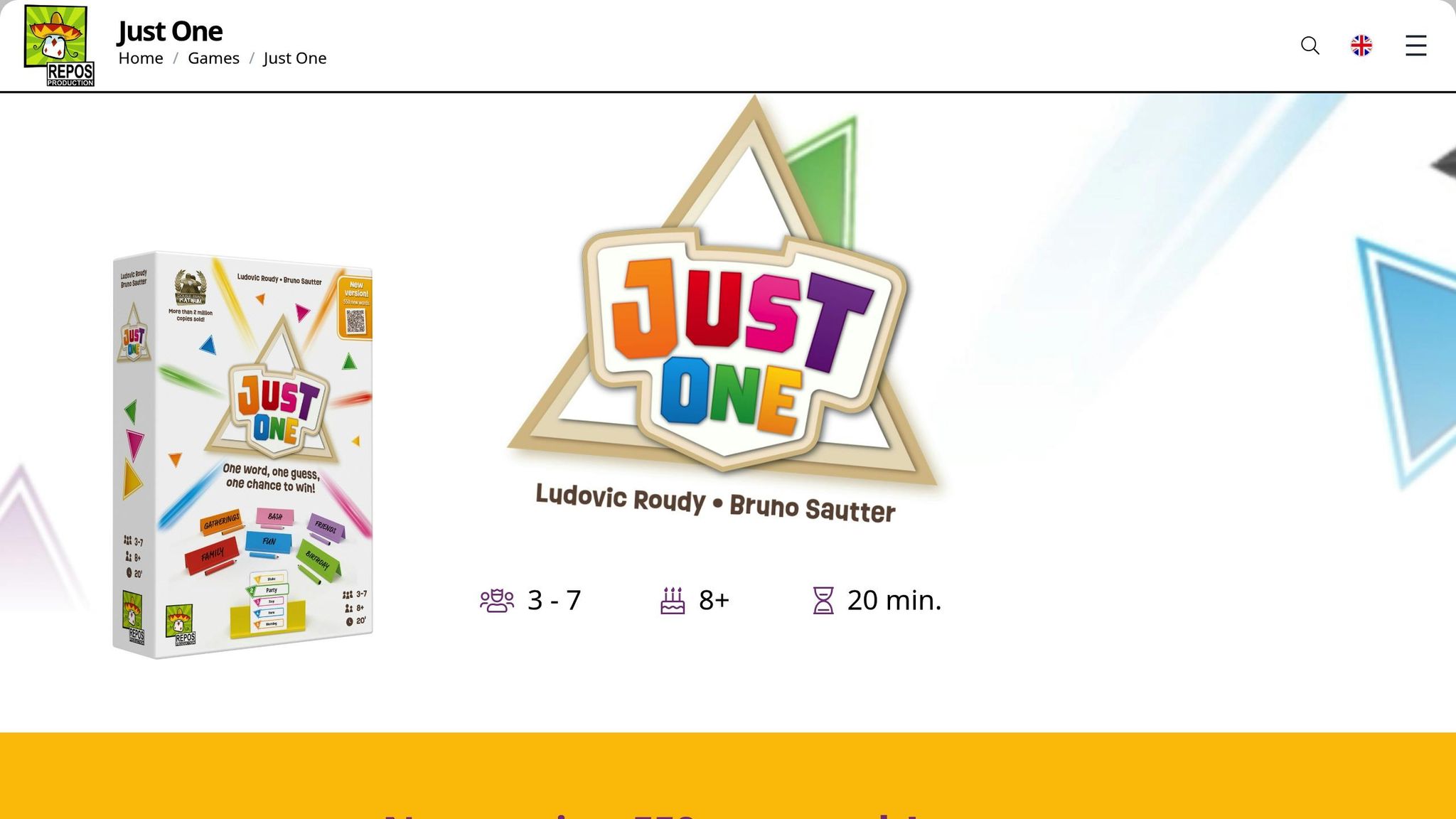
Just One brings a hilarious twist to word-guessing games. In this cooperative challenge, one player takes the guessing role while everyone else writes down a one-word clue. But there’s a catch - if two or more players write the same clue, it gets erased before the guesser ever sees it.
Imagine the secret word is "pizza", and three players independently write "Italian." Since duplicates disappear, the guesser is left with clues like "round" and "cheese." The result? Wild guesses and plenty of laughs. Let’s dive into what makes Just One such a hit.
Ease of Learning
The beauty of Just One lies in its simplicity. The rules boil down to this: write a one-word clue, compare with others, eliminate duplicates, and let the guesser try their luck. No complicated scoring or thick rulebooks here - new players can jump in within 30 seconds. That means less time explaining and more time laughing.
Player Interaction
The game thrives on shared moments. When clues are revealed and duplicates vanish, you’ll hear groans, laughter, and collective anticipation as the guesser tries to connect the dots. The cooperative nature ensures that every success - and every ridiculous misstep - feels like a team effort, making it a game everyone can enjoy together.
Chaos and Laughter Factor
The unpredictability is where Just One truly shines. When obvious clues like "pet", "bark", or "animal" are removed for a word like "dog", the remaining hints might be as random as "mailman" or "park." These unexpected connections lead to guesses that are so off-the-wall, they’ll have the whole group in stitches.
Group Size Suitability
Perfect for 3 to 7 players, Just One works well with both small and medium-sized groups. In smaller games, every clue matters more, while larger groups bring higher chances of overlap, ramping up the chaos. The game also balances personalities - quiet players can shine with clever clues, while more outgoing players can take center stage when it’s their turn to guess.
Ready to add some laughter to your game nights? You can grab Just One at Brain Games and see why it’s a crowd favorite.
2. Codenames
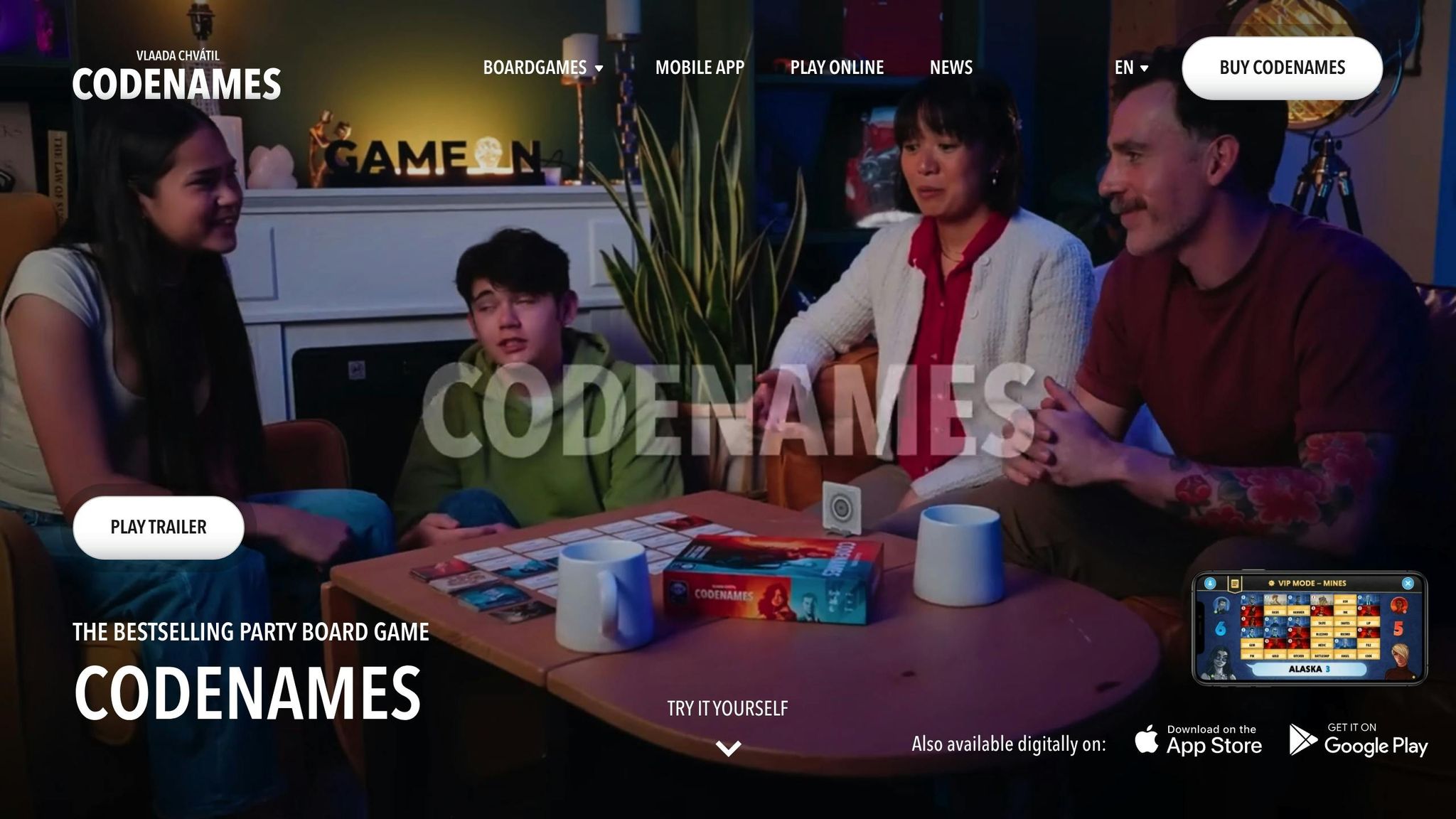
Codenames is a clever word association game where teams of spies must rely on teamwork and intuition. The goal? Decode the spymaster's clues to identify your agents on the board. Each spymaster gives a one-word clue paired with a number, hinting at how many words are connected to that clue. The operatives then deliberate and attempt to pick the correct words, working together to outsmart the opposing team.
Ease of Learning
One of the game's biggest strengths is its simplicity. The spymaster provides a one-word hint and a number, and the team brainstorms to match the clue to the correct words. This straightforward structure ensures the game is easy to pick up, while still encouraging players to think outside the box and communicate effectively.
Player Interaction
Teamwork is the beating heart of Codenames. Each operative brings their own interpretation of the spymaster’s clue, leading to lively discussions as they try to agree on the best choices. On the other side, the spymaster’s challenge is to connect as many words as possible with a single clue, adding a layer of strategy that keeps everyone engaged.
Game Mechanics and Tension
One of the most exciting rules in Codenames is the option to make an extra guess beyond the number given in the clue. This mechanic often creates nail-biting moments as teams weigh the risks of pushing their luck versus playing it safe. It’s a perfect balance of strategy and suspense that keeps players on their toes.
Group Size Suitability
The standard version of Codenames is designed with a four-player setup in mind - each team has one spymaster and one operative. This format fosters focused communication and strategy, making it a fantastic choice for smaller gatherings or intimate game nights.
Think your team has what it takes to crack the code? Grab your copy of Codenames at Brain Games and put your skills to the test!
3. Dixit

Dixit brings storytelling to life with its beautifully illustrated cards. Players take turns as the storyteller, offering a clue about their chosen card, while others submit cards they think match the clue. Then, everyone votes on which card they believe belongs to the storyteller. The result? A game full of creativity, surprises, and shared laughter.
Ease of Learning
Dixit is refreshingly simple to learn. Each round, the storyteller gives a clue about their card. Other players then choose a card from their hand that they think fits that clue. Once all cards are revealed, everyone votes on which card they think is the storyteller's. This easy-to-follow format ensures new players can jump in and start having fun almost immediately.
Player Interaction
What makes Dixit truly special is the way it encourages creative interaction. Instead of focusing on competition, the game thrives on imagination and interpretation. Storytellers need to strike a balance - crafting clues that are neither too obvious nor too cryptic. Meanwhile, other players interpret these clues in their own unique ways, leading to fascinating discussions and insights into how people think. It’s a game that sparks conversation and connection.
Chaos and Laughter Factor
The joy of Dixit lies in the unexpected. A clue like "childhood memories" might lead to cards that range from whimsical to downright bizarre. When the cards are revealed, the results can be hilarious, especially when the storyteller’s card takes everyone by surprise. These moments of misinterpretation and surprise are what make Dixit a laugh-out-loud experience.
Group Size Suitability
Dixit works best with 4–6 players but can accommodate 3–6 players (or up to 12 with expansions). Larger groups add even more diversity to the mix, making the game feel fresh and unpredictable. With more players, the range of interpretations and card submissions grows, creating a lively and engaging atmosphere perfect for parties and gatherings.
Ready to dive into the world of Dixit? Grab your copy at Brain Games and see why this enchanting game has captured hearts around the globe!
4. Wavelength

Wavelength is a lively social guessing game where teams work together to find a hidden bullseye along a spectrum of opposing ideas. Each round, one player becomes the "Psychic" and gives a single clue to guide their team toward the target. The closer the team’s guess is to the bullseye, the more points they score.
Ease of Learning
Learning Wavelength is a breeze. The Psychic draws a card featuring two opposing concepts, secretly checks the target location on the dial, and then provides a one-word clue. With its simple rules and an average playtime of 30 to 45 minutes, most groups pick it up quickly and can dive into multiple rounds without missing a beat.
Player Interaction
This game thrives on team collaboration. Players share ideas, debate interpretations, and work together to align their guesses - all of which add to the excitement of each round. Like other party games, Wavelength relies on straightforward rules and encourages active participation.
Group Size Suitability
Whether you’re playing with a small group of four or a larger crowd, Wavelength adapts easily to different group sizes, keeping everyone engaged and part of the action.
Think your group is in sync? Grab Wavelength at Brain Games and see how well you can read each other’s minds!
5. Telestrations
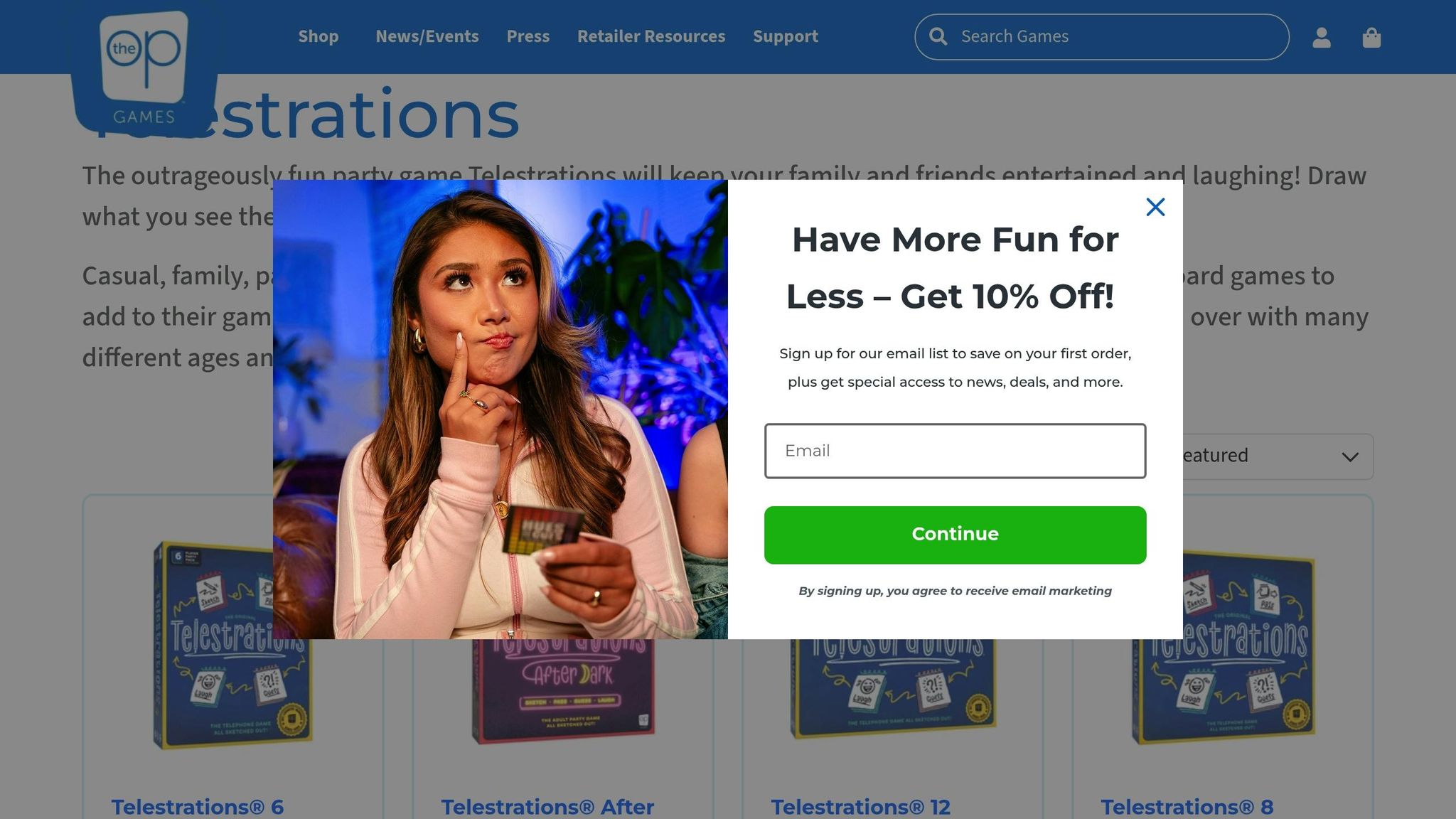
Telestrations takes the classic game of telephone and adds a hilarious twist with drawing and guessing. Players alternate between sketching a word and guessing what others have drawn, creating a chain of misinterpretations that almost always leads to laugh-out-loud results.
Ease of Learning
This game is incredibly easy to pick up - explaining the rules takes just a few minutes. And don’t worry about your artistic skills (or lack thereof); in fact, the worst drawings often make for the best laughs. Designed for ages 8 and up, it’s a wonderful choice for gatherings that span generations, from kids to grandparents.
Chaos and Laughter Factor
The real fun kicks in when simple words morph into bizarre interpretations. Imagine starting with "roller coaster" and ending up with "snake on a ladder" after a few rounds of sketching and guessing. The big reveal is where the magic happens, as everyone gets to see the hilarious evolution of their original word. Each round feels like a mini comedy show, with unexpected twists keeping everyone entertained.
The anticipation builds as players eagerly await to see just how far their word has strayed from its original meaning. It’s this shared laughter that makes Telestrations a hit at any gathering.
Player Interaction
What sets Telestrations apart is how it keeps everyone engaged the entire time. While one person is drawing, others are busy guessing, ensuring there’s never a dull moment. The highlight, though, is the reveal phase - when the group reviews the chain of drawings and guesses, leading to plenty of laughs and lighthearted teasing.
It’s no surprise that board game enthusiasts consistently rank Telestrations as one of the top party games. Its charm lies in its inclusivity - whether you’re a skilled artist or someone who struggles with stick figures, everyone adds to the fun and chaos.
Group Size Suitability
The game works best with 6 to 8 players, but the party edition can handle up to 12. Whether you’re playing with a smaller group or a larger crowd, the gameplay adapts beautifully. Bigger groups mean more outrageous transformations, while smaller ones offer a more intimate and focused experience.
Curious to see just how wild your group’s interpretations can get? Pick up Telestrations at Brain Games and get ready for an unforgettable time!
6. Decrypto
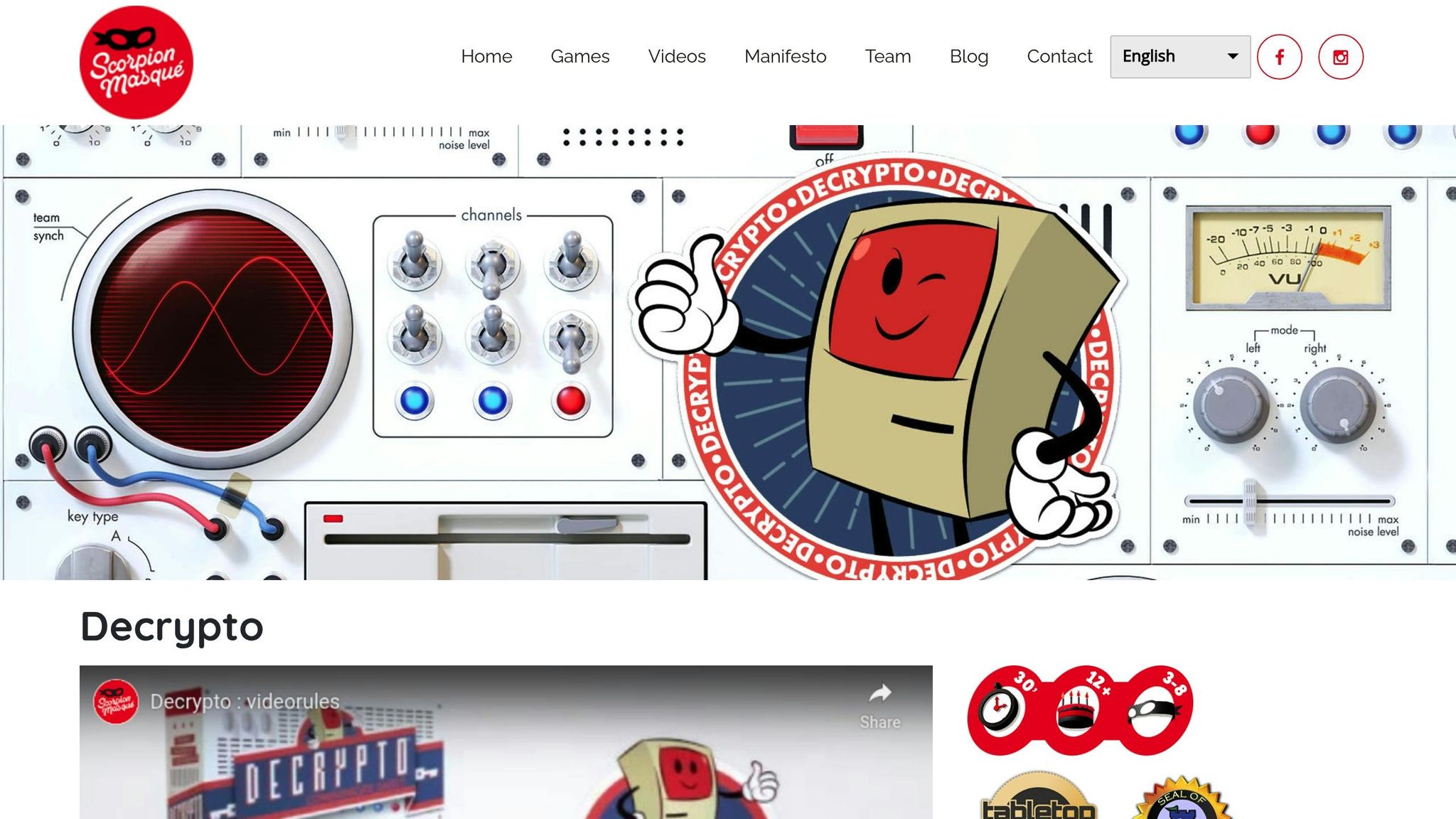
Decrypto adds a layer of espionage to your game night, pitting two teams against each other in a battle to crack secret codes. This word game masterfully balances tension and fun as players try to give just the right amount of information to their teammates without tipping off their opponents.
Ease of Learning
The concept is simple: each team has four secret words, each tied to a number from 1 to 4. The goal? Give clues that help your team guess the correct sequence of numbers without revealing it to the opposing side. Sounds easy, right? Not so fast. The real challenge is finding that sweet spot - being clear enough for your teammates but vague enough to keep your rivals in the dark.
Getting started with Decrypto is straightforward, making it accessible to everyone. However, mastering the art of crafting clever, strategic clues takes a bit of creativity and practice. This learning curve keeps the game engaging and ensures every round feels fresh and mentally stimulating.
Player Interaction
Interaction is at the heart of Decrypto. It’s not just about giving clues; it’s about outsmarting the other team while staying one step ahead. Every clue you give is like a double-edged sword - it could help your team or unintentionally aid your opponents. This dynamic fosters collaboration and quick thinking, as teams huddle together, strategizing and analyzing every word.
Unlike games where players take individual turns, Decrypto keeps everyone involved throughout. While one team works on their clues, the other team is busy trying to decipher them, creating an atmosphere of shared focus and friendly competition.
Chaos and Laughter Factor
The real fun kicks in when the clues become more challenging. As the game progresses, players can’t reuse old hints, forcing them to come up with increasingly creative - and sometimes downright ridiculous - ways to communicate. Imagine trying to describe "ocean" without using water-related terms. The results? Hilariously inventive clues and plenty of laughter.
The tension ramps up as teams inch closer to victory or defeat. Cracking an opponent’s code is thrilling, while watching your own code get intercepted leads to those “how did they figure that out?!” moments. These highs and lows spark lively post-game discussions and make Decrypto a game you’ll want to play again and again.
Group Size Suitability
Decrypto shines with 3 to 8 players, offering a flexible setup that works for both small and medium-sized groups. For three players, there’s a special variant where one player acts as the interceptor, trying to crack the team’s codes twice within five rounds. This tweak keeps the game’s core tension intact while making it just as engaging for smaller gatherings.
For larger groups, while the game remains fun, individual participation can sometimes feel a bit diluted. Smaller groups tend to keep everyone more deeply involved in the deduction process, which enhances the overall experience.
Ready to put your communication skills to the test and see if your team can outwit the competition? Grab Decrypto at Brain Games and discover why it’s a go-to choice for fans of mentally challenging party games!
sbb-itb-1ed942f
7. Spyfall

Spyfall transforms your game night into a thrilling espionage experience where no one can be trusted. In this deduction-based game, players find themselves in various settings - from a submarine to a casino. The twist? One player is the spy, unaware of the location, trying to figure it out without blowing their cover.
Ease of Learning
The beauty of Spyfall lies in its simplicity. Each player gets a card showing the same location - except for one person, who receives the "spy" card. Players take turns asking each other questions about the location, aiming to unmask the spy. Meanwhile, the spy listens carefully, gathering clues to blend in. The real challenge isn’t learning the rules - it’s mastering the art of asking clever questions without revealing too much.
Player Interaction
The game shines through its lively and unpredictable player interactions. Every round is packed with probing questions and quick thinking. For instance, a question like, "What’s the best thing about working here?" might seem harmless but can easily trip up a spy who doesn’t know if they’re supposed to be in a jungle or a movie studio. The spy must stay sharp, contributing to conversations about a location they know nothing about, all while avoiding suspicion.
Chaos and Laughter Factor
Spyfall thrives on moments of doubt and hilarity. A vague answer like "I enjoy the view" could send the group into a frenzy of accusations. The spy’s attempts to gather information - whether smooth or hilariously awkward - often lead to laugh-out-loud moments that make every round unforgettable.
Group Size Suitability
Designed for 3 to 8 players, Spyfall hits its sweet spot with 5 to 6 participants. With only 3 players, the spy’s role becomes extra challenging, as there’s little room to hide. On the other hand, larger groups of 7 to 8 make it easier for the spy to blend in. For even bigger gatherings, Spyfall 2 raises the player cap to 12 and introduces the option of two spies. However, some players feel that adding multiple spies can make the game a bit more chaotic.
Ready for an evening of suspicion and laughter? Grab your copy of Spyfall at Brain Games and enjoy countless rounds of guessing, bluffing, and unexpected "aha!" moments!
8. Monikers
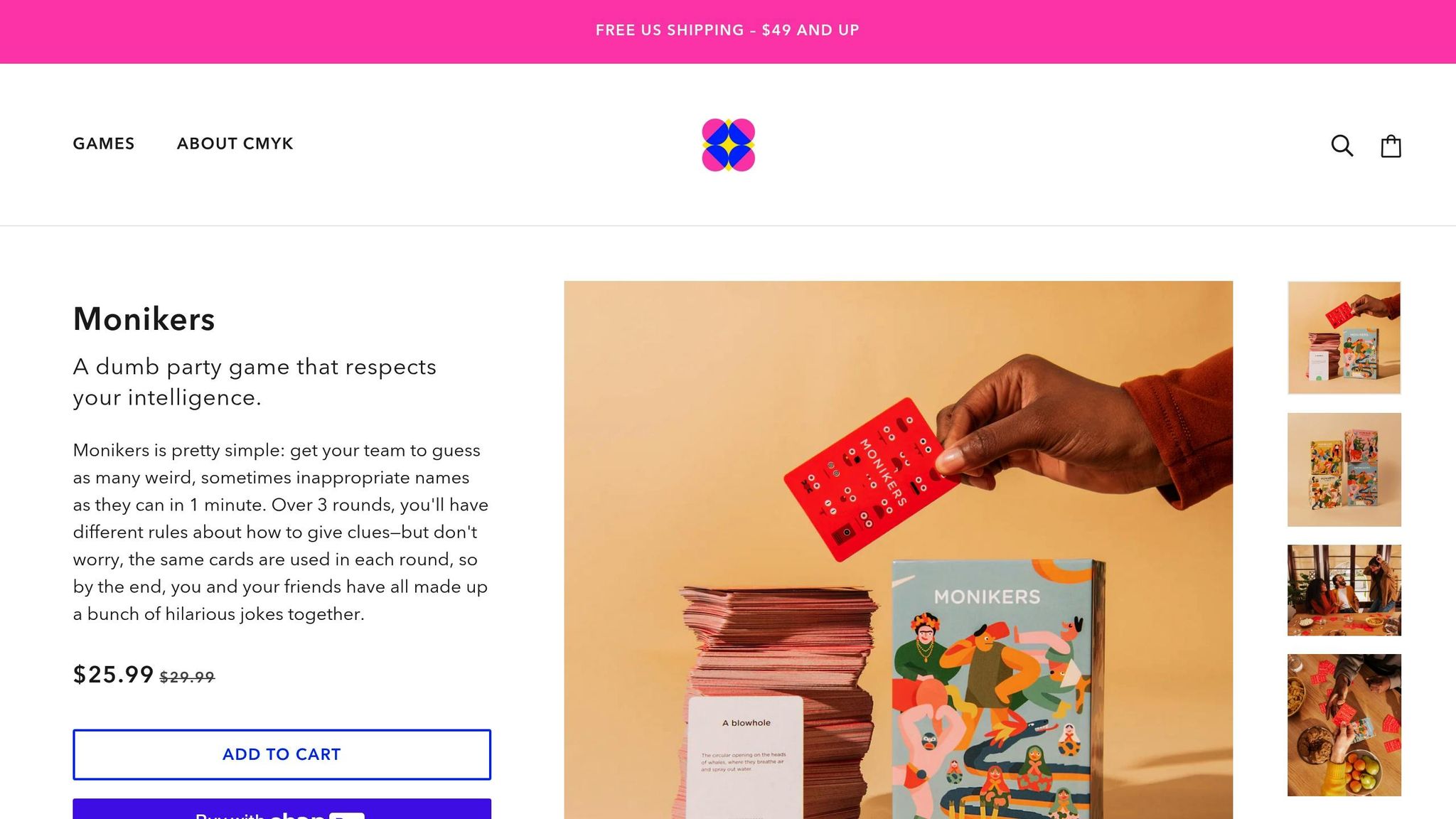
Monikers takes the classic idea of charades and dials up the fun. This team-based party game challenges players to guess names and concepts from cards, but there’s a twist: you use the same deck across three rounds, each with stricter rules. What starts as straightforward clue-giving quickly turns into wild gestures and shared jokes, leaving everyone in fits of laughter.
Ease of Learning
One of the best things about Monikers is how easy it is to pick up. You can explain the rules in under five minutes, making it ideal for groups where not everyone is familiar with modern board games. The three-round setup - starting with freeform descriptions, followed by single-word clues, and ending with silent gestures - keeps the gameplay intuitive and fast-paced.
Player Interaction
This game thrives on teamwork and creativity. Unlike games where players might sit idle during others' turns, Monikers keeps everyone engaged. Teams often develop their own inside jokes and shortcuts, creating hilarious and unforgettable moments. It’s the kind of game that gets everyone talking and laughing together.
Chaos and Laughter Factor
As the rounds progress, the restrictions on clue-giving lead to increasingly ridiculous scenarios. Imagine someone confidently describing a famous celebrity in round one, only to resort to over-the-top pantomime by the final round. A single exaggerated motion can turn into a running joke for the entire evening. The cards, loaded with pop culture references and quirky phrases, add to the hilarity - something reflected in over 2,000 Amazon reviews with an impressive 4.8/5 rating.
Group Size Suitability
Whether you have 4 players or a crowd of 12, Monikers adapts seamlessly to your group. The team-based format means the more, the merrier. Plus, the shared laughs and callbacks to earlier rounds make it even funnier as the game goes on.
You can snag Monikers for about $24.99–$29.99 at Brain Games. Expansion packs, priced around $15–$20 each, are also available to keep your game nights fresh and full of laughs. Ready to see how Monikers stacks up against other top party games? Check out our Party Game Comparison Chart in the next section!
9. Pictomania
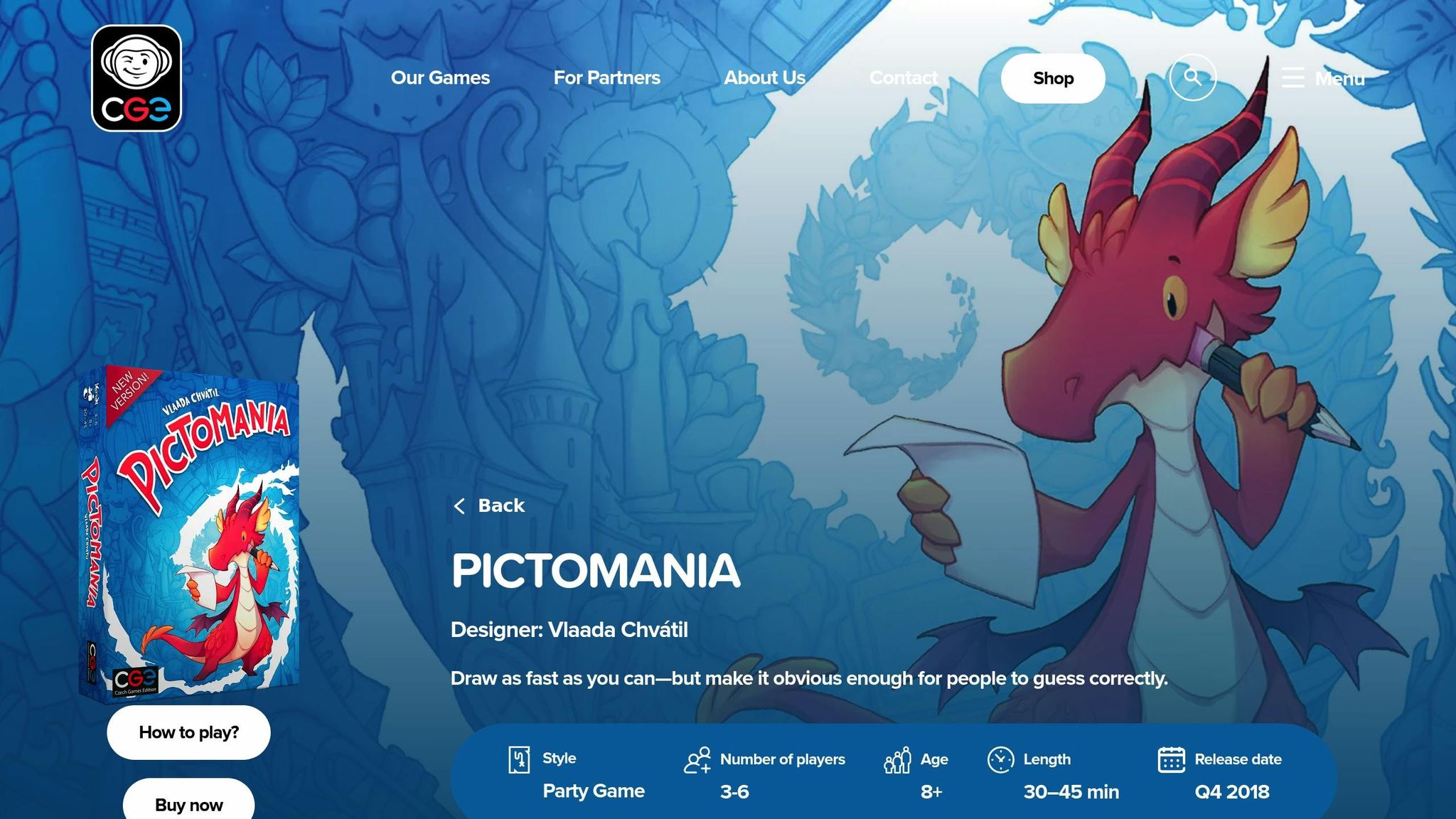
Pictomania transforms drawing into a high-energy, fast-paced party game where everyone is involved simultaneously. Instead of waiting for turns, players draw and guess at the same time, creating a lively and fun atmosphere. The focus isn’t on artistic talent but on speed and quick thinking, making it perfect for groups looking for an interactive experience.
Simple and Quick to Learn
The game’s rules are easy to pick up: everyone sketches at once while trying to figure out what others are drawing. The faster and more accurate your guesses, the more bonus tokens you earn, adding a fun competitive twist.
Encouraging Player Interaction
Pictomania thrives on interaction, as players constantly watch and interpret each other’s drawings. Game designer Jason Meyers explains it best:
"Pictomania is a unique and wild party/social activity that alleviates the fears of those who can't draw about participating in this genre of games."
A Recipe for Chaos and Laughter
The simultaneous gameplay creates a whirlwind of activity. Picture a group frantically sketching and shouting out guesses - it’s chaotic, hilarious, and endlessly entertaining. The result is a game night filled with energy and laughter.
You can grab Pictomania for $19.99–$24.99 at Brain Games. It’s an excellent choice to bring a burst of creativity and fun to your next gathering.
10. Skull
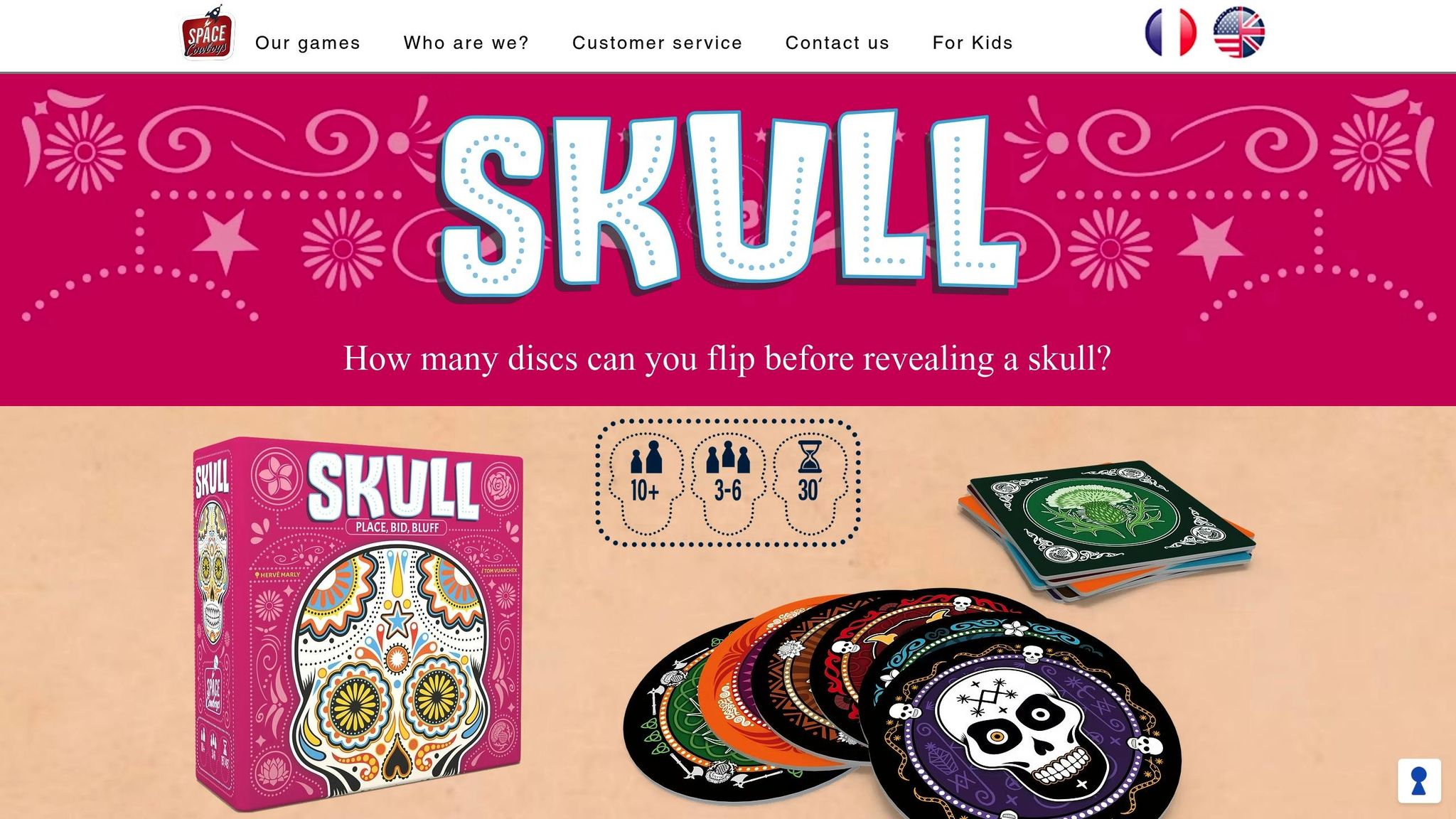
Skull is a bluffing game that turns simple mechanics into a battlefield of wits and deception. Using just four discs per player - three flowers and one skull - it creates an experience packed with tension, laughter, and a touch of psychological warfare. The premise is straightforward: players secretly place discs, bid on how many they can flip without hitting a skull, and then watch the chaos unfold. It's a game of nerve, strategy, and reading your opponents, all wrapped up in a sleek, minimalist design.
Ease of Learning
Skull is incredibly easy to pick up, making it perfect for parties with players of all experience levels. The rules are simple: place a disc, bid, and flip. You can explain the entire game in under five minutes, and there’s no need for a lengthy setup or complex instructions. It’s accessible fun for anyone aged 10 and up, and since there’s no board or cards to shuffle, you can dive straight into the action.
Player Interaction
This game thrives on interaction, pulling players into a web of bluffing and second-guessing. Every glance, hesitation, or confident bid becomes a clue - or a trap. Skull is all about reading people: is someone bluffing, or are they daring you to take the bait? When a bold bid is made, it’s essentially a challenge to the entire table, creating moments of direct confrontation that are as thrilling as they are nerve-wracking.
The best moments come during those tense standoffs when someone has to decide whether to call a bluff or back down. These psychological showdowns have everyone at the table hanging on every move, making Skull a game that’s as much about people as it is about mechanics.
Chaos and Laughter Factor
The unpredictability of Skull is what makes it so entertaining. Imagine this: a player confidently bids to flip five discs, successfully reveals four flowers, and then - bam! - flips a skull on the last one. The table erupts in laughter as their boldness turns into a spectacular failure.
These dramatic moments happen often. The player who seems unsure might be hiding nothing but flowers, while the overconfident one might be sitting on a skull. This constant guessing game creates a roller coaster of tension and hilarity, keeping everyone engaged and ready for the next round.
Group Size Suitability
Skull works best with 4 to 6 players, where the bluffing and misdirection hit their peak. With four players, the game feels tight and strategic, but with six, it becomes a whirlwind of social chaos and unexpected twists. The more players you have, the harder it is to read the table, which only adds to the excitement.
While you can technically play with three, Skull truly comes alive with larger groups. The added players make the game more dynamic, amplifying both the tension and the laughter. It’s the kind of high-energy interaction that makes it a standout choice for parties or casual game nights.
You can grab Skull for about $15.00–$20.00 at Brain Games. It’s a small price for a game that guarantees big laughs and unforgettable moments at your gatherings.
Party Game Comparison Chart
Finding the right party game for your gathering can be tricky, but this chart breaks down essential details to help you decide. Whether you're planning for a small group or a big crowd, short bursts of fun or longer sessions, the chart below highlights key factors like player count, playtime, chaos level, learning curve, and price.
| Game | Players | Playtime | Chaos Level | Learning Difficulty | Price Range |
|---|---|---|---|---|---|
| Codenames | 2–8+ | 15–30 min | Medium | Easy | $24.95 |
| Dixit | 3–8 | 30–45 min | Medium | Easy | $31.99 |
| Wavelength | 2–12 | 45 min | High | Medium | $35.09 |
| Telestrations | 4–8 | 30–60 min | Very High | Easy | $40.99 |
| Decrypto | 3–8 | 15–45 min | Medium | Medium | $24.99 |
The chaos level gives you a sense of how unpredictable and wild the gameplay can get. For instance, Telestrations scores "Very High" because it thrives on hilarious misunderstandings and unexpected twists, while Wavelength brings a creative edge to the chaos with its unique guessing mechanics. On the other hand, games like Codenames and Decrypto keep the excitement more controlled, focusing on strategy and communication.
Learning difficulty measures how quickly new players can pick up the game. Most of these titles are beginner-friendly and can be explained in just a few minutes. However, Wavelength and Decrypto take a little more time to grasp due to their distinctive mechanics, but they’re still accessible for first-timers.
When it comes to price, the range reflects current market averages. Games like Telestrations and Wavelength come with a slightly higher price tag, but their replayability and engaging gameplay make them worthwhile. Meanwhile, options like Codenames and Decrypto deliver excellent entertainment at a more budget-friendly cost.
Shorter games like Codenames are perfect for quick bursts of fun, while longer options like Telestrations are ideal for keeping the momentum going during extended gatherings. Whether you're after a laugh-out-loud experience or something more strategic, these metrics make it easier to find the perfect fit for your party.
For more details, including customer reviews, check out these games at Brain Games.
Tips for Hosting a Game Night
With our list of chaotic games ready to go, it's time to make sure your game night setup matches the energy of the games themselves. A little planning can go a long way in creating a fun, memorable evening. From setting up the space to choosing the right games, these tips will help you make the most of your gathering.
Setting Up Your Space for Success
The way you arrange your space can set the tone for the entire night. Try arranging seating in a circle or semi-circle to encourage eye contact and interaction among players. Clear off any unnecessary items from your table, leaving only essentials like coasters and trays for snacks and drinks.
Lighting plays a big role in creating the right vibe. Use warm, even lighting to make the space feel cozy, and steer clear of harsh overhead lights. Keep the room at a comfortable temperature - around 68–72°F (20–22°C) - and ensure good ventilation, especially if you're hosting a larger group. A well-thought-out setup makes it easier for everyone to focus on the fun.
Choosing Games That Match Your Group
The right game can make or break the night. Think about your group's dynamics - do they thrive on competition, or do they prefer working together? For groups that haven’t played together before, start with quick, light games to break the ice and get a feel for everyone’s preferences.
Flexibility is crucial when it comes to group size. Attendance can be unpredictable, so have a mix of games that work well for different numbers of players. Cooperative games are ideal for smaller groups, as they encourage teamwork and reduce competitive tension. For larger gatherings, opt for games that involve storytelling, deduction, or creative thinking to keep the energy high.
Managing Food and Drinks Strategically
Snacks and drinks are an essential part of any game night, but they can also be a source of chaos if not managed well. Stick to finger foods and set up a separate beverage station to minimize the risk of spills. Use small bowls or trays for snacks to keep things tidy and accessible without cluttering the playing area.
Keep some cleaning supplies, like hand sanitizers and wipes, within reach for quick cleanups between games. This not only keeps the space neat but also shows your guests that you’ve put thought into every detail.
Keeping Energy High Throughout the Night
To keep the momentum going, offer a variety of games with different lengths and let your guests vote on what to play next. This way, everyone feels included in the decision-making process. Be prepared to switch games if one isn’t resonating with the group - staying flexible is key to maintaining a lively atmosphere.
Mix shorter games with longer ones to create natural breaks and prevent fatigue. For example, games like Codenames are perfect for quick 15–30 minute sessions, while Telestrations can keep a group entertained for much longer when the mood is right.
"With the right setup, you can create an unforgettable experience that keeps friends coming back." - EverythingBoardGames.com
Handling the Unexpected
No matter how well you plan, surprises are bound to happen. Maybe a game doesn’t land well with your group, or you get a last-minute addition to the guest list. Having backup games and maintaining a go-with-the-flow attitude can turn these moments into part of the fun rather than stressors.
Keep extra supplies like score pads, pens, and batteries on hand to avoid interruptions. The goal is to create an environment where laughter and connection come naturally.
With thoughtful preparation, a little flexibility, and the right games (check out Brain Games for inspiration), your game night can be the kind of event people remember - and talk about - for weeks to come.
Conclusion
The right party games can turn a simple get-together into an unforgettable evening of laughter and fun. Whether you're diving into the imaginative storytelling of Dixit, laughing over the hilarious miscommunication in Telestrations, or feeling the suspense in the deduction-filled rounds of Spyfall, each game brings its own flavor of excitement, breaking the ice and bringing people closer together.
What truly sets these games apart isn’t just their rules or gameplay - it’s the memories they create. Picture someone attempting an impossible doodle in Pictomania, or the collective cheer when a team finally cracks the code in Decrypto. These moments stick with you, sparking connections that last long after the game is over.
The real magic of these games lies in their unpredictability. A single clue or word can lead to hilarious chaos, turning an ordinary evening into something extraordinary. It’s this delightful unpredictability that makes game nights so legendary.
If you're ready to bring some chaos and laughter to your next gathering, you can find all these amazing games at Brain Games. Their curated collection of party games is perfect for creating those unforgettable moments, and they even offer a Game Exchange Guarantee to ensure you find the right fit.
Your next game night is waiting. Embrace the chaos, and let the memories begin.
FAQs
How do I pick a party game that works for a group with different interests and experience levels?
When picking the perfect party game for a group with different interests and experience levels, aim for games that are simple to grasp and adaptable enough to suit everyone. Choose options with straightforward rules, short rounds, and the ability to tweak difficulty or gameplay.
Think about the group’s vibe - age range, energy level, and how familiar they are with playing games. A blend of fun, interactive, and easygoing activities - like trivia, charades, or cooperative games - can make sure everyone feels involved and enjoys themselves. Focusing on inclusivity and shared laughter will make your gathering a hit!
How can I keep everyone engaged during a game night, especially with a large group?
To keep everyone engaged during a game night with a larger group, try splitting into small teams or pairs. This setup promotes collaboration and makes sure everyone has a chance to join in the fun. Opt for games that are quick to pick up and inclusive, like charades or trivia, to keep the energy high and the mood light.
Switching up activities throughout the night can add variety and ensure no one feels left out. Create a vibrant atmosphere by encouraging teamwork, friendly competition, and lots of laughter. Including a mix of games that appeal to different interests and personalities will make the evening enjoyable and memorable for everyone.
What are some tips for creating the perfect game night atmosphere?
How to Set the Perfect Game Night Atmosphere
Creating the right vibe for game night starts with making sure everyone feels at ease. Arrange enough seats so no one’s left standing, and use warm, soft lighting to give the space a cozy, inviting feel. Stock up on snacks and drinks - because let’s face it, good food keeps the energy high. Adding small touches like pillows or blankets can make the space even more comfortable.
Be prepared by organizing the games ahead of time. Set up any game pieces, shuffle cards, and skim through the rules so you’re not fumbling mid-game. This keeps things running smoothly and avoids those awkward pauses. Most importantly, keep the mood light and welcoming. Encourage breaks when needed and make sure everyone feels part of the fun. A relaxed and inclusive atmosphere is the secret to a game night everyone will remember.






